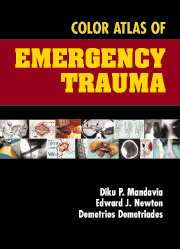8 - SKIN AND SOFT TISSUE INJURY
Published online by Cambridge University Press: 10 November 2010
Summary
Introduction
The skin, being the largest organ and exposed, is very susceptible to injury, ranging from contusions to deep extensive burns. Furthermore, deeper soft tissue injury can lead to extensive blood loss, tendon injury, neurovascular trauma, and acute compartment syndrome. More than 1.25 million burns are evaluated in emergency departments across the United States annually, and these burns account for about 12,000 deaths each year. Burn injuries to the skin can be cosmetically and functionally devastating, and they account for many years of productive lives lost.
Acute burn evaluation requires special expertise and knowledge, given the unique complications these injuries can have. Careful history is important. Patients involved in closed-space fires with poor ventilation are at especially high risk for inhalational injury and carbon monoxide poisoning. The clinician needs to consider associated blunt trauma injury that may be related to a fall or an attempt to escape the flames. Suicide attempt victims may also have ingested poisons, and thus a coexistent toxicological emergency must be considered.
Clinical Examination
The standard primary survey with ABCDE evaluation is paramount. During this survey, careful attention to facial burns and possible inhalational injury is necessary, as these patients may require immediate airway control. Impaired lung ventilation may be detected by the presence of chest burn eschar or bronchospasm. Signs of shock secondary to third-space fluid loss and/or blood loss from another associated injury may be noted. A brief neurological examination is important to determine the possibility of head or spinal injury, and during the exposure evaluation all clothing should be removed to evaluate the extent of skin and soft tissue injury.
- Type
- Chapter
- Information
- Color Atlas of Emergency Trauma , pp. 259 - 284Publisher: Cambridge University PressPrint publication year: 2003



